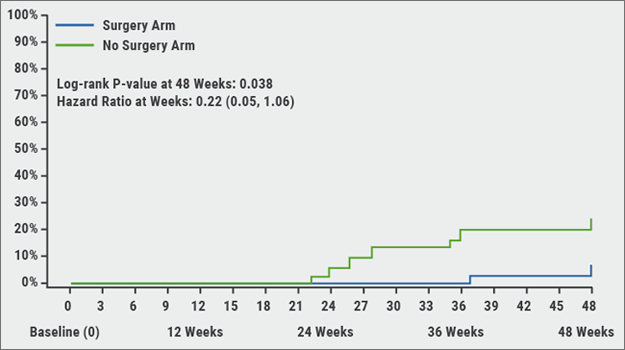The German COSYCONET cohort strives to investigate the trajectory of COPD with special regard to systemic factors and comorbidity. Dr Franziska Trudzinski (University Hospital Centre Heidelberg, Germany) assessed in a new analysis whether gender-specific differences, when present in symptoms of COPD, could influence the diagnosis of cardiac comorbidities [1]. Included were 2,046 individuals (38.9% women) from COSYCONET with information on clinical history, comorbidity status, and lung function. Also available were results of the 8-item COPD Assessment Test (CAT) and Medical Research Council Dyspnoea Scale (mMRC). Mean age was 65 years, BMI was 26.6 kg/m2, Global Initiative for Chronic Obstructive Lung Disease (GOLD) classifications 1–4, ratio for forced expiratory volume in 1 second/forced vital capacity ratio (FEV1/FVC) was 51.6. Smoking status was assessed as well. Using multivariate regression, gender-associated differences in the link between symptoms, functional impairments, comorbidities, and the distinct CAT items were evaluated. Furthermore, data on cardiac disease, represented by coronary artery disease, heart failure, and myocardial infarction, was valued individually for women and men to assess for possible predictors of cardiac comorbidity.
The study discovered noteworthy differences between women and men for certain CAT items, as well as for the majority of functional parameters and comorbidities. Cough (CAT 1), phlegm (CAT 2), and activities (CAT 5) were significantly dissimilar between genders (P<0.05). For gender-specific disparities in the relationship of symptoms, functional parameters, and comorbidities, associations were apparent for energy (CAT 8) and activities (CAT 5) in men and chest tightness (CAT 3) in women. These same CAT items per gender were also associated with cardiac disease. The authors deduced that gender-specific differences in COPD not only comprised differences in levels of symptoms, comorbidities, and functional alterations but also differences in their mutual relationships. These findings suggest that diagnostic information should be used differently in men and women.
- Trudzinski FC, et al. Gender-Specific Differences in COPD Symptoms and Their Impact for the Diagnosis of Cardiac Comorbidities: Results from COSYCONET. Session TP39: COPD Comorbidities. ATS 2021 International Conference, 14-19 May.
Copyright ©2021 Medicom Medical Publishers
Posted on
Previous Article
« Younger adults with COPD at higher health risk than previously thought Next Article
Severe exacerbations: A key driver of all-cause mortality in COPD patients »
« Younger adults with COPD at higher health risk than previously thought Next Article
Severe exacerbations: A key driver of all-cause mortality in COPD patients »
Table of Contents: ATS 2021
Featured articles
Letter from the Editor
COVID-19: What Pulmonologists Need to Know
Antibody treatment for COVID-19: a combination is successful
Air pollution: an underestimated negative prognostic factor for COVID-19
Healthcare workers vulnerable to SARS-CoV-2 infections
Genetic risk variants responsible for COVID-19 predisposition
Asthma – An Update
“As-needed” inhaled corticosteroid therapy for mild asthma – what is the evidence?
IL-4/13 blocker successful in treatment of paediatric moderate-to-severe asthma
Benralizumab lives up to its phase 3 results in real-world findings
Tezepelumab – good success rates in various types of severe asthma
Sleep Disorders – An Underestimated Problem
OSA: A risk factor for earlier cognitive decline
Subgroup of patients with high heart rate response and coronary artery disease benefit from CPAP
Association between positive airway pressure treatment adherence and COVID-19 infection rates
COPD – What Is New
Possible aetiologies for COPD exacerbations – more evidence is needed
Does COPD plus COVID-19 equal higher mortality?
Biomarkers for acute exacerbations in COPD are required
Severe exacerbations: A key driver of all-cause mortality in COPD patients
Men and women with COPD differ in many ways
Younger adults with COPD at higher health risk than previously thought
Metabolic Dysregulation and Lung Disease
Obesity: A risk factor for new-onset asthma and worse asthma control
Metabolic dysfunction and lung disease: children are no small adults
Best of the Posters
Air pollution in winter linked to more hospital admissions in ILD patients
Tobacco biomarkers do not improve prediction of lung cancer risk
Vaping identified as risk factor for asthma
Related Articles
July 18, 2022
New guidelines for IPF and PPF

November 7, 2018
Gastroesophageal reflux, IPF and lessons learned
© 2024 Medicom Medical Publishers. All rights reserved. Terms and Conditions | Privacy Policy
HEAD OFFICE
Laarderhoogtweg 25
1101 EB Amsterdam
The Netherlands
T: +31 85 4012 560
E: publishers@medicom-publishers.com

